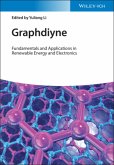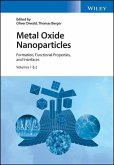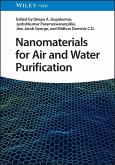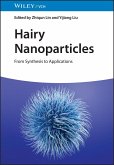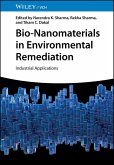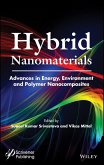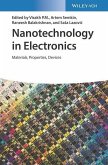- Gebundenes Buch
- Merkliste
- Auf die Merkliste
- Bewerten Bewerten
- Teilen
- Produkt teilen
- Produkterinnerung
- Produkterinnerung
Covers the fundamental concept, synthesis,characterization, properties, and applications of nanoscaled amorphous materials.
Andere Kunden interessierten sich auch für
![Graphdiyne Graphdiyne]() Graphdiyne184,51 €
Graphdiyne184,51 €![Metal Oxide Nanoparticles, 2 Volume Set Metal Oxide Nanoparticles, 2 Volume Set]() Metal Oxide Nanoparticles, 2 Volume Set443,99 €
Metal Oxide Nanoparticles, 2 Volume Set443,99 €![Nanomaterials for Air and Water Purification Nanomaterials for Air and Water Purification]() Nanomaterials for Air and Water Purification112,99 €
Nanomaterials for Air and Water Purification112,99 €![Hairy Nanoparticles Hairy Nanoparticles]() Hairy Nanoparticles112,99 €
Hairy Nanoparticles112,99 €![Bio-Nanomaterials in Environmental Remediation Bio-Nanomaterials in Environmental Remediation]() Bio-Nanomaterials in Environmental Remediation104,99 €
Bio-Nanomaterials in Environmental Remediation104,99 €![Hybrid Nanomaterials Hybrid Nanomaterials]() Hybrid Nanomaterials241,99 €
Hybrid Nanomaterials241,99 €![Nanotechnology in Electronics Nanotechnology in Electronics]() Nanotechnology in Electronics159,00 €
Nanotechnology in Electronics159,00 €-
-
-
Covers the fundamental concept, synthesis,characterization, properties, and applications of nanoscaled amorphous materials.
Hinweis: Dieser Artikel kann nur an eine deutsche Lieferadresse ausgeliefert werden.
Hinweis: Dieser Artikel kann nur an eine deutsche Lieferadresse ausgeliefert werden.
Produktdetails
- Produktdetails
- Verlag: Wiley-VCH
- Artikelnr. des Verlages: 1134747 000
- 1. Auflage
- Erscheinungstermin: 24. März 2021
- Englisch
- Abmessung: 251mm x 176mm x 27mm
- Gewicht: 990g
- ISBN-13: 9783527347476
- ISBN-10: 352734747X
- Artikelnr.: 60397500
- Herstellerkennzeichnung
- Wiley-VCH GmbH
- Boschstr. 12
- 69469 Weinheim
- wiley.buha@zeitfracht.de
- www.wiley-vch.de
- Verlag: Wiley-VCH
- Artikelnr. des Verlages: 1134747 000
- 1. Auflage
- Erscheinungstermin: 24. März 2021
- Englisch
- Abmessung: 251mm x 176mm x 27mm
- Gewicht: 990g
- ISBN-13: 9783527347476
- ISBN-10: 352734747X
- Artikelnr.: 60397500
- Herstellerkennzeichnung
- Wiley-VCH GmbH
- Boschstr. 12
- 69469 Weinheim
- wiley.buha@zeitfracht.de
- www.wiley-vch.de
Lin Guo, Professor, is the executive dean of School of Chemistry, Beihang University, China. He has received several scientific awards include the Humboldt Fellowship Award, Germany in 2001, the Outstanding Youth Fund from Nature Science Foundation of China in 2007, the Yangtze River Scholars Distinguished Professor in 2011, Prize of National Natural Science of China in 2013. Also, he is the Fellow of the Royal Society Chemistry in 2015. His research interests focus on synthesis, characterization, and applications of zero-, one, two and three-dimensional nanomaterials.
Chapter 1 Introduction
1.1 Introduction of Amorphous Material
1.2 Structural Differences of Amorphous Material and Crystal
1.3 History of the Amorphous Materials
1.4 Growth Mechanism of Amorphous Nanomaterials
References
Chapter 2 Local Structure and Electronic State of Amorphous Nanomaterials
2.1 Spherical Aberration Corrected Transmission Electron Microscopy
2.1.1 Introduction
2.1.2 Spherical Aberration Corrected Transmission Electron Microscopy
2.1.3 Electron Energy-loss Spectroscopy in the TEM
2.1.4 Characterization of Amorphous Materials by Using In-situ TEM with Aberration Corrector
2.1.5 Summary and Outlook
2.2 X-ray Absorption Fine Structure Spectrum
2.2.1 Introduction
2.2.2 Extended X-ray Absorption Fine Structure
2.2.3 X-ray Absorption Near Edge Structure
2.2.4 Application in Amorphous Nanomaterials
2.2.5 Summary and Outlooks
References
Chapter 3 Defect Characterization of Amorphous Nanomaterials
3.1 Introduction
3.2 Defect Identification in Semiconductors with PAS
3.3 Defect Analysis in Nanomaterials by EPR
3.4 Defect Activated PL Spectroscopy
References
Chapter 4 The Synthesis Methods of 0D Amorphous Nanomaterials
4.1 Introduction
4.2 The Bottom-up Approach
4.3 The Top-down Approach
4.4 Summary and Outlook
References
Chapter 5 The Synthesis Methods of 1D Amorphous Nanomaterials
5.1 Introduction
5.2 The Synthesis Methods of 1D Amorphous Nanomaterials
5.2.1 Hydrothermal/Solvothermal Method
5.2.2 Chemical Precipitation Method
5.2.3 Electrochemical Deposition Method
5.2.4 Templating Method
5.2.5 Other Synthetic Methods
5.3 Summary and Outlook
References
Chapter 6 The Synthesis Methods of 2D Amorphous Nanomaterials
6.1 Introduction
6.2 Thermal Decomposition Method
6.3 Exfoliation Method
6.4 Deposition Method
6.4.1 Physical Vapor Deposition Method
6.4.2 Electrodeposition Method
6.5 Chemical Precipitation Method
6.6 Template Method
6.7 Phase Transformation Method
6.8 Sol-Gel Method
6.9 Element Doping Method
6.10 Summary and Outlook
References
Chapter 7 Synthesis of 3D Amorphous Nanomaterials
7.1 Introduction
7.2 Template-Engaged Strategies
7.2.1 Coordinating Etching Method
7.2.2 Acid/Alkali Etching Method
7.2.3 Redox Etching Method
7.2.4 Self-Templated Method
7.3 Electrochemical Method
7.4 Hydrothermal/Solvothermal Method
7.5 Common Solution Method
7.6 Laser/Ultrasonic-Assisted Solution Method
7.7 Other Special Strategies
7.8 Conclusions and Outlook
References
Chapter 8 Amorphous Coated and Amorphous Doped or Hybrid Nanomaterials
8.1 Introduction
8.2 Amorphous Coated Nanomaterial by Atomic Layer Deposition
8.2.1 Amorphous Metal Oxide Thin Film Coating
8.2.2 Other Amorphous Thin Film Coating
8.3 Amorphous/Crystalline Structural Nanomaterials
8.3.1 1D Amorphous Coated Nanomaterials
8.3.1.1 Crystalline-Amorphous Homojunction Nanostructure
8.3.1.2 Crystalline-Amorphous Heterojunction Nanostructure
8.3.2 2D Amorphous Coated Nanomaterials
8.3.2.1 Carbon-based 2D Nanostructure
8.3.2.2 Amorphous Nanosheets on Ni Foam
8.3.2.3 Amorphous Metal Compounds Nanoplates
8.3.3 3D Amorphous Coated Nanomaterials
8.3.3.1 Silica Coating
8.3.3.2 Carbon Coating
8.3.3.3 Metal Oxide Coating
8.3.3.4 Metal Sulfide Coating
8.4 Amorphous Doped or Hybrid Nanomaterials
8.4.1 2D Amorphous Doped or Hybrid Crystalline Nanomaterials
8.4.2 3D Amorphous Doped or Hybrid Crystalline Nanomaterial
8.4.2.1 Two-Phase Metal Oxide Structure
8.4.2.2 Hollow Structure
8.5 Conclusion and Outlook
Reference
Chapter 9 The Application of Amorphous Nanomaterials in Electrocatalysis
9.1 Introduction
9.2 Fundamentals of Electrocatalysis and the Roles of Catalysts
9.3 Amorphous Materials as Electrocatalysts for Water Sp
1.1 Introduction of Amorphous Material
1.2 Structural Differences of Amorphous Material and Crystal
1.3 History of the Amorphous Materials
1.4 Growth Mechanism of Amorphous Nanomaterials
References
Chapter 2 Local Structure and Electronic State of Amorphous Nanomaterials
2.1 Spherical Aberration Corrected Transmission Electron Microscopy
2.1.1 Introduction
2.1.2 Spherical Aberration Corrected Transmission Electron Microscopy
2.1.3 Electron Energy-loss Spectroscopy in the TEM
2.1.4 Characterization of Amorphous Materials by Using In-situ TEM with Aberration Corrector
2.1.5 Summary and Outlook
2.2 X-ray Absorption Fine Structure Spectrum
2.2.1 Introduction
2.2.2 Extended X-ray Absorption Fine Structure
2.2.3 X-ray Absorption Near Edge Structure
2.2.4 Application in Amorphous Nanomaterials
2.2.5 Summary and Outlooks
References
Chapter 3 Defect Characterization of Amorphous Nanomaterials
3.1 Introduction
3.2 Defect Identification in Semiconductors with PAS
3.3 Defect Analysis in Nanomaterials by EPR
3.4 Defect Activated PL Spectroscopy
References
Chapter 4 The Synthesis Methods of 0D Amorphous Nanomaterials
4.1 Introduction
4.2 The Bottom-up Approach
4.3 The Top-down Approach
4.4 Summary and Outlook
References
Chapter 5 The Synthesis Methods of 1D Amorphous Nanomaterials
5.1 Introduction
5.2 The Synthesis Methods of 1D Amorphous Nanomaterials
5.2.1 Hydrothermal/Solvothermal Method
5.2.2 Chemical Precipitation Method
5.2.3 Electrochemical Deposition Method
5.2.4 Templating Method
5.2.5 Other Synthetic Methods
5.3 Summary and Outlook
References
Chapter 6 The Synthesis Methods of 2D Amorphous Nanomaterials
6.1 Introduction
6.2 Thermal Decomposition Method
6.3 Exfoliation Method
6.4 Deposition Method
6.4.1 Physical Vapor Deposition Method
6.4.2 Electrodeposition Method
6.5 Chemical Precipitation Method
6.6 Template Method
6.7 Phase Transformation Method
6.8 Sol-Gel Method
6.9 Element Doping Method
6.10 Summary and Outlook
References
Chapter 7 Synthesis of 3D Amorphous Nanomaterials
7.1 Introduction
7.2 Template-Engaged Strategies
7.2.1 Coordinating Etching Method
7.2.2 Acid/Alkali Etching Method
7.2.3 Redox Etching Method
7.2.4 Self-Templated Method
7.3 Electrochemical Method
7.4 Hydrothermal/Solvothermal Method
7.5 Common Solution Method
7.6 Laser/Ultrasonic-Assisted Solution Method
7.7 Other Special Strategies
7.8 Conclusions and Outlook
References
Chapter 8 Amorphous Coated and Amorphous Doped or Hybrid Nanomaterials
8.1 Introduction
8.2 Amorphous Coated Nanomaterial by Atomic Layer Deposition
8.2.1 Amorphous Metal Oxide Thin Film Coating
8.2.2 Other Amorphous Thin Film Coating
8.3 Amorphous/Crystalline Structural Nanomaterials
8.3.1 1D Amorphous Coated Nanomaterials
8.3.1.1 Crystalline-Amorphous Homojunction Nanostructure
8.3.1.2 Crystalline-Amorphous Heterojunction Nanostructure
8.3.2 2D Amorphous Coated Nanomaterials
8.3.2.1 Carbon-based 2D Nanostructure
8.3.2.2 Amorphous Nanosheets on Ni Foam
8.3.2.3 Amorphous Metal Compounds Nanoplates
8.3.3 3D Amorphous Coated Nanomaterials
8.3.3.1 Silica Coating
8.3.3.2 Carbon Coating
8.3.3.3 Metal Oxide Coating
8.3.3.4 Metal Sulfide Coating
8.4 Amorphous Doped or Hybrid Nanomaterials
8.4.1 2D Amorphous Doped or Hybrid Crystalline Nanomaterials
8.4.2 3D Amorphous Doped or Hybrid Crystalline Nanomaterial
8.4.2.1 Two-Phase Metal Oxide Structure
8.4.2.2 Hollow Structure
8.5 Conclusion and Outlook
Reference
Chapter 9 The Application of Amorphous Nanomaterials in Electrocatalysis
9.1 Introduction
9.2 Fundamentals of Electrocatalysis and the Roles of Catalysts
9.3 Amorphous Materials as Electrocatalysts for Water Sp
Chapter 1 Introduction
1.1 Introduction of Amorphous Material
1.2 Structural Differences of Amorphous Material and Crystal
1.3 History of the Amorphous Materials
1.4 Growth Mechanism of Amorphous Nanomaterials
References
Chapter 2 Local Structure and Electronic State of Amorphous Nanomaterials
2.1 Spherical Aberration Corrected Transmission Electron Microscopy
2.1.1 Introduction
2.1.2 Spherical Aberration Corrected Transmission Electron Microscopy
2.1.3 Electron Energy-loss Spectroscopy in the TEM
2.1.4 Characterization of Amorphous Materials by Using In-situ TEM with Aberration Corrector
2.1.5 Summary and Outlook
2.2 X-ray Absorption Fine Structure Spectrum
2.2.1 Introduction
2.2.2 Extended X-ray Absorption Fine Structure
2.2.3 X-ray Absorption Near Edge Structure
2.2.4 Application in Amorphous Nanomaterials
2.2.5 Summary and Outlooks
References
Chapter 3 Defect Characterization of Amorphous Nanomaterials
3.1 Introduction
3.2 Defect Identification in Semiconductors with PAS
3.3 Defect Analysis in Nanomaterials by EPR
3.4 Defect Activated PL Spectroscopy
References
Chapter 4 The Synthesis Methods of 0D Amorphous Nanomaterials
4.1 Introduction
4.2 The Bottom-up Approach
4.3 The Top-down Approach
4.4 Summary and Outlook
References
Chapter 5 The Synthesis Methods of 1D Amorphous Nanomaterials
5.1 Introduction
5.2 The Synthesis Methods of 1D Amorphous Nanomaterials
5.2.1 Hydrothermal/Solvothermal Method
5.2.2 Chemical Precipitation Method
5.2.3 Electrochemical Deposition Method
5.2.4 Templating Method
5.2.5 Other Synthetic Methods
5.3 Summary and Outlook
References
Chapter 6 The Synthesis Methods of 2D Amorphous Nanomaterials
6.1 Introduction
6.2 Thermal Decomposition Method
6.3 Exfoliation Method
6.4 Deposition Method
6.4.1 Physical Vapor Deposition Method
6.4.2 Electrodeposition Method
6.5 Chemical Precipitation Method
6.6 Template Method
6.7 Phase Transformation Method
6.8 Sol-Gel Method
6.9 Element Doping Method
6.10 Summary and Outlook
References
Chapter 7 Synthesis of 3D Amorphous Nanomaterials
7.1 Introduction
7.2 Template-Engaged Strategies
7.2.1 Coordinating Etching Method
7.2.2 Acid/Alkali Etching Method
7.2.3 Redox Etching Method
7.2.4 Self-Templated Method
7.3 Electrochemical Method
7.4 Hydrothermal/Solvothermal Method
7.5 Common Solution Method
7.6 Laser/Ultrasonic-Assisted Solution Method
7.7 Other Special Strategies
7.8 Conclusions and Outlook
References
Chapter 8 Amorphous Coated and Amorphous Doped or Hybrid Nanomaterials
8.1 Introduction
8.2 Amorphous Coated Nanomaterial by Atomic Layer Deposition
8.2.1 Amorphous Metal Oxide Thin Film Coating
8.2.2 Other Amorphous Thin Film Coating
8.3 Amorphous/Crystalline Structural Nanomaterials
8.3.1 1D Amorphous Coated Nanomaterials
8.3.1.1 Crystalline-Amorphous Homojunction Nanostructure
8.3.1.2 Crystalline-Amorphous Heterojunction Nanostructure
8.3.2 2D Amorphous Coated Nanomaterials
8.3.2.1 Carbon-based 2D Nanostructure
8.3.2.2 Amorphous Nanosheets on Ni Foam
8.3.2.3 Amorphous Metal Compounds Nanoplates
8.3.3 3D Amorphous Coated Nanomaterials
8.3.3.1 Silica Coating
8.3.3.2 Carbon Coating
8.3.3.3 Metal Oxide Coating
8.3.3.4 Metal Sulfide Coating
8.4 Amorphous Doped or Hybrid Nanomaterials
8.4.1 2D Amorphous Doped or Hybrid Crystalline Nanomaterials
8.4.2 3D Amorphous Doped or Hybrid Crystalline Nanomaterial
8.4.2.1 Two-Phase Metal Oxide Structure
8.4.2.2 Hollow Structure
8.5 Conclusion and Outlook
Reference
Chapter 9 The Application of Amorphous Nanomaterials in Electrocatalysis
9.1 Introduction
9.2 Fundamentals of Electrocatalysis and the Roles of Catalysts
9.3 Amorphous Materials as Electrocatalysts for Water Sp
1.1 Introduction of Amorphous Material
1.2 Structural Differences of Amorphous Material and Crystal
1.3 History of the Amorphous Materials
1.4 Growth Mechanism of Amorphous Nanomaterials
References
Chapter 2 Local Structure and Electronic State of Amorphous Nanomaterials
2.1 Spherical Aberration Corrected Transmission Electron Microscopy
2.1.1 Introduction
2.1.2 Spherical Aberration Corrected Transmission Electron Microscopy
2.1.3 Electron Energy-loss Spectroscopy in the TEM
2.1.4 Characterization of Amorphous Materials by Using In-situ TEM with Aberration Corrector
2.1.5 Summary and Outlook
2.2 X-ray Absorption Fine Structure Spectrum
2.2.1 Introduction
2.2.2 Extended X-ray Absorption Fine Structure
2.2.3 X-ray Absorption Near Edge Structure
2.2.4 Application in Amorphous Nanomaterials
2.2.5 Summary and Outlooks
References
Chapter 3 Defect Characterization of Amorphous Nanomaterials
3.1 Introduction
3.2 Defect Identification in Semiconductors with PAS
3.3 Defect Analysis in Nanomaterials by EPR
3.4 Defect Activated PL Spectroscopy
References
Chapter 4 The Synthesis Methods of 0D Amorphous Nanomaterials
4.1 Introduction
4.2 The Bottom-up Approach
4.3 The Top-down Approach
4.4 Summary and Outlook
References
Chapter 5 The Synthesis Methods of 1D Amorphous Nanomaterials
5.1 Introduction
5.2 The Synthesis Methods of 1D Amorphous Nanomaterials
5.2.1 Hydrothermal/Solvothermal Method
5.2.2 Chemical Precipitation Method
5.2.3 Electrochemical Deposition Method
5.2.4 Templating Method
5.2.5 Other Synthetic Methods
5.3 Summary and Outlook
References
Chapter 6 The Synthesis Methods of 2D Amorphous Nanomaterials
6.1 Introduction
6.2 Thermal Decomposition Method
6.3 Exfoliation Method
6.4 Deposition Method
6.4.1 Physical Vapor Deposition Method
6.4.2 Electrodeposition Method
6.5 Chemical Precipitation Method
6.6 Template Method
6.7 Phase Transformation Method
6.8 Sol-Gel Method
6.9 Element Doping Method
6.10 Summary and Outlook
References
Chapter 7 Synthesis of 3D Amorphous Nanomaterials
7.1 Introduction
7.2 Template-Engaged Strategies
7.2.1 Coordinating Etching Method
7.2.2 Acid/Alkali Etching Method
7.2.3 Redox Etching Method
7.2.4 Self-Templated Method
7.3 Electrochemical Method
7.4 Hydrothermal/Solvothermal Method
7.5 Common Solution Method
7.6 Laser/Ultrasonic-Assisted Solution Method
7.7 Other Special Strategies
7.8 Conclusions and Outlook
References
Chapter 8 Amorphous Coated and Amorphous Doped or Hybrid Nanomaterials
8.1 Introduction
8.2 Amorphous Coated Nanomaterial by Atomic Layer Deposition
8.2.1 Amorphous Metal Oxide Thin Film Coating
8.2.2 Other Amorphous Thin Film Coating
8.3 Amorphous/Crystalline Structural Nanomaterials
8.3.1 1D Amorphous Coated Nanomaterials
8.3.1.1 Crystalline-Amorphous Homojunction Nanostructure
8.3.1.2 Crystalline-Amorphous Heterojunction Nanostructure
8.3.2 2D Amorphous Coated Nanomaterials
8.3.2.1 Carbon-based 2D Nanostructure
8.3.2.2 Amorphous Nanosheets on Ni Foam
8.3.2.3 Amorphous Metal Compounds Nanoplates
8.3.3 3D Amorphous Coated Nanomaterials
8.3.3.1 Silica Coating
8.3.3.2 Carbon Coating
8.3.3.3 Metal Oxide Coating
8.3.3.4 Metal Sulfide Coating
8.4 Amorphous Doped or Hybrid Nanomaterials
8.4.1 2D Amorphous Doped or Hybrid Crystalline Nanomaterials
8.4.2 3D Amorphous Doped or Hybrid Crystalline Nanomaterial
8.4.2.1 Two-Phase Metal Oxide Structure
8.4.2.2 Hollow Structure
8.5 Conclusion and Outlook
Reference
Chapter 9 The Application of Amorphous Nanomaterials in Electrocatalysis
9.1 Introduction
9.2 Fundamentals of Electrocatalysis and the Roles of Catalysts
9.3 Amorphous Materials as Electrocatalysts for Water Sp


